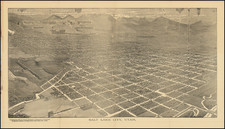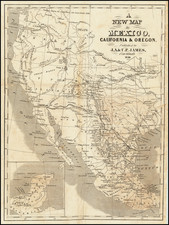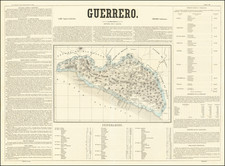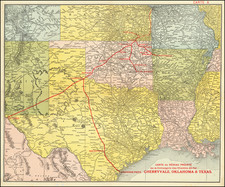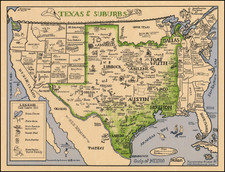Comanches and Apaches from Texas Attacking Northern Mexico
Gov. Trias of Chihuahua Responds to "Incursiones de Indios Barbaros"
Historical Background for Cormac McCarthy's Blood Meridian
This extremely rare Mexican provincial imprint - printed in the northern state of Chihuahua - contains fresh local reporting concerning the ongoing devastation wrought by Texas-based Comanches and Apaches upon residents of northern Mexico. The text of the present Chihuahua government publication, printed by Cayetano Ramos in Chihuahua City, is largely taken up with the subject of Indian depredations. Included are proclamations by Angel Trías, recently installed governor of Chihuahua, concerning the official response to the violent attacks. There are also reports by and about General Francisco García Conde and several first-hand reports of Indian raids, captivities, and retaliations, with mentions of Nagué (Natchez), José Chato, Maturán, and other tribal leaders.
Background:
As United States-Mexico relations deteriorated in the 1830s and 1840s, native tribes based in Texas intensified their incursions into Mexico, causing local governments in northern Mexican states such as Chihuahua and Sonora to hire American "scalp hunters" to track down and kill native raiders. Irish-born James (Don Santiago) Kirker became famous for bringing in hundreds of "proofs" (i.e. scalps) of dead Indians. John Joel Glanton, a Texas Ranger, led a notorious band of scalp hunters into Mexico during the late 1840s, providing inspiration for several characters in Cormac McCarthy's novel Blood Meridian.
Angel Trías, who became governor of Chihuahua in August 1845, went to great lengths to counter the devastating incursions by Comanches and Apaches in his state. As Texas-based Indians continued to raid farms and ranchos in northern Mexico throughout the 1840s, killing innocent residents and stealing large numbers of livestock and horses, Trías tried to clamp down on the situation. He recommended travelers carry arms, and ordered males over 17 years of age to enlist as Defenders of the Department.
Trías, who entered office August 24, 1845, became one of Chihuahua's most outstanding governors. A man of action and of considerable cultural interest, he co-operated with the national government against the United States and tackled the Indian menace on the domestic front... He created a Junta de Auxiliares to assist forces intended for the reconquest of Texas.... - Ralph A. Smith, "Indians in American-Mexican Relations Before the War of 1846," Hispanic American Historical Review (1963) 43 (1): page 57.
[During the 1840s] columns in gazettes of north Mexico states overflowed with pitiful tales about Indians sweeping away unfortunate persons and confirm what one historian of the Comanches (Rupert N. Richardson) has described as "the most horrendous holocaust ever enacted against a civilized people in the Western World." In exchange for their staples of trade, they received from the civilized people cloth, paints, rifles, powder, lead, knives, guns, and iron from which to make arrow and lance points. Eastern tribes moved by the United States government to the Indian Territory sold many of their government-issued rifles to Comanches for five dollars each. Mexican authorities complained about American traffic with these Indians and also saw the Yankee image behind Apache raids. - Ralph A. Smith, "The Comanche Invasion of Mexico in the Fall of 1845," West Texas Historical Association Year Book 35 (Oct. 1959), pages 3-28.
Partial English translation:
Angel Trías: Governor of the Department of Chihuahua--To the prefects of the Departments of this city and of Hidalgo, I direct that as of this date the Secretary circulate this communication. "Today has departed from this capital the General in chief of the 5th Division Don Francisco G. Conde, whose zeal, activity and ardent desire for the pacification of the land, who is well known to all inhabitants; but contrary to all of his plans and due to a lack of financial resources coming from the Governor and from many persons who know the fatal causes which have nullified those to whom promises are owed, and now an opportunity arises for His Excellency to support the patriotism of those settlements nearest to the theatre of important operations of the troops against the Comanches, to the end that is such a manner they can help them to have the most indispensable means.
Vigorously assisted by the settlements of Durango another section of the 5th Division has resulted in the recent great triumphs in that Department, and in Chihuahua, no less given in valor, nor in heroism, so that the same can be carried out, the complete down fall of the savages, chasing them in their flight and completing at one time, this war of desolation and extermination which has gone on for many years. All resources must serve this intent: grain, horses, cattle, serapes, etc., which must be religiously paid, for the task so well recognized by the General-in-Chief, according to his requirements. The armed men who voluntarily wish to make this campaign with the troops, submitting to the orders of the chiefs, will be pressed into the service of the Department, and their government will always consider and appreciate their complete valor and zeal of the authorities in this respect is equally appreciated and considered....God and Liberty. Chihuahua, October 27, 1845 - Angel Trías - Senior General in Chief of the 5th Division of Military.
INCURSIONS of BARBAROUS INDIANS.
Prefecture of the District of Chihuahua. The First Justice of the Peace of Satevó, forwards the following, dated 18th instant:
Now that it is 7:00 at night, the foreman of Lic. D. Ignacio Ochoa having just arrived, who tells me that at 6 in the morning, the Apache descended on the old ranch, 30 in number, who made him accompany them and took all the horses and did the same thing with those at Mastranzal and Ojo de Agua, which they descended upon at the same time, and the same foreman said they left them in the Sierra del Colegio at 10 o'clock the same day on which they were captured, with three Apache women; therefore I took it upon myself to send a party to see if it had occurred and give to your Excellency prompt reports about these occurrences. Oct. 21, 1845. J. Felix Maceyra.
-----
Fifth Military Division - General in Chief - Honorable Sir, The Commander of the Frontier of Janos in communication no. 6, 10 of September, states as follows:
General in Chief, Today, the 14th of this month there arrived at this presidio Maria Dolores Madrid, wife of Felipe Ornelas, one of those captured by the Apache in the Monte de las Hormigas, and one of those to whom I made reference in copy #1, which accompanied my communication no. 4, this captive says that she escaped at the watering place of Visnegas, a distance of 9 or 10 leagues from this presidio, on the 10th of the current month in the night when where was a robbery of corn from the fields of this place, she says that in her group of captives there were two other women and three children, there were only 14 Apaches that had attacked them at the watering hole, and made reference to a robbery in which they captured horses and cattle, this had taken place in the Arroyo de Alamos, where they separated from the enemy and four of them took this route with six women and headed for the Mogollon; the chieftan who was in charge of this action was the Indian Nagué (Natchez) and there was also Maturan and Chato, and Nague was their owner and had brought them to the place where she escaped, in the company of Padilla with 20 troops that could be spared to pursue them that way, causing them to abandon the horses because only five men remained to guard them, with the purpose of seeing if they would be successful in attacking the four Apache and taking away what they had robbed, but this could not be carried out since they could not be found at the watering hole where they had left them, and only found the tracks which he followed for four days continuing towards the Mogollon, so the returned to the presidio, becuase of the distance the enemy had already traveled, and because of the lack of forage for the troops. There were constant hostilities by the enemy along the way, robbing some haciendas of cattle and corn, and they can not be chased for great distances because I do not have the troops and supplies are few. I cannot count on the residents of the area as there are no more than 18 or 20...Chihuahua Oct. 22, 1845 - Francisco G. Conde.
-----
....The evening of the 25th instant the rear guard was attacked by the enemy Apaches in Cienega del Rio, three leagues from this Presidio...
....Your Excellency well knows that the 5th Division lacks the resources to protect the three Departments of Durango, Chihuahua, and New Mexico, which are invaded and devastated by the Apaches and Comanches, and other savage tribes, as well as being threatened by the United States of America. - Cuartel General en la Concepcion. Oct. 31, 1845. Francisco G. Conde.
Caravan from the United States
I call your attention to the arrival of caravan from New Mexico, which passed this day through this capital, en route to other Departments of the Republic. The Central Government orders that it be carefully monitored... I request the assistance of the troops to the end that they may escort the wagons: I send these dispositions to the Prefects, Sub-Prefects and Justices of the Peace... I ask the Commander of the Army for a sufficient police force to guard against damages until they leave.
Rarity:
Extremely rare in the market. No record of original examples are noted in OCLC. Only a single example of a bound run sold in RBH.











